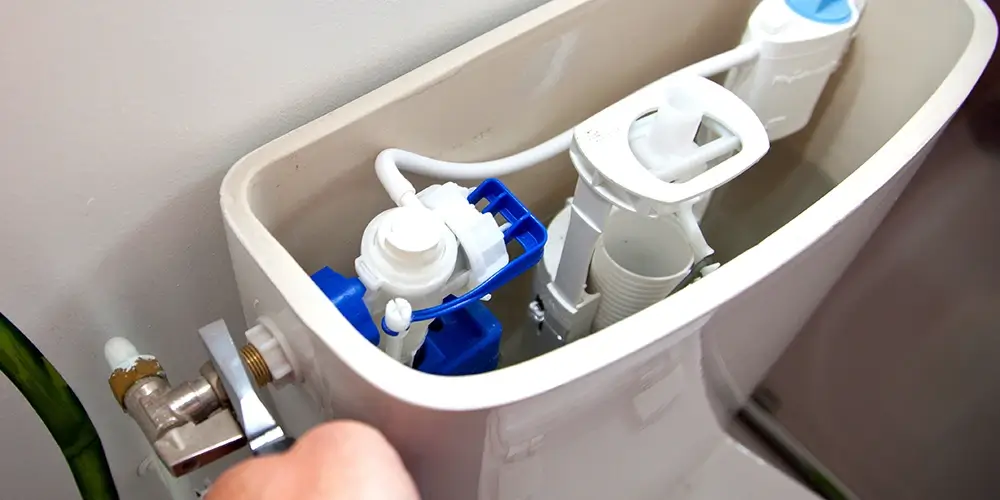Upgrading a toilet may not be a glamorous DIY project, but it’s a real money saver.
It’s also a cheap and easy way to cut back — wa-a-ay back — on your water use during Southern California’s frequent droughts.
Did you know that an aging toilet can use 5 to 7 gallons of water per flush and that the average American makes a ‘comfort call’ 6 or 7 times daily?
That adds up to 42 gallons of water per day per person. In a household of four, it equates to nearly 170 gallons daily flushed down the sewer pipe. Compare that to the 1.28 gallons per of most low-flush toilets. Some ultra-low-flow toilets use as little as 0.8 gallons per flush.
Orange County, CA, implemented new water restrictions in June 2022. These focused primarily on outdoor landscape watering, limiting it to specific days per week, but — trust us — they’re coming for your toilet next.
Not all Southern Californians have switched to low-flush toilets. Despite regulations mandating low-flow toilets in California homes, many old, inefficient toilets remain in use.
So what can you do if you live in an older home with aging but serviceable toilets and don’t have the scratch to replace them all? Or if your landlord refuses to bring an old toilet up to code?
The good news is that there are several cheap toilet upgrades to transform your old porcelain throne into a water-saving machine.
1. Install a Dual-Flush Converter
This device lets you choose between a full flush or a half flush, depending on the waste in the bowl. The mechanism operates through a specially designed valve that adjusts the water volume released.
The cost of a dual-flush converter can range from $20 to $50, making it a budget-friendly option for homeowners looking to upgrade their toilets without replacing them entirely.
Installing it is a relatively simple DIY project that doesn’t require professional plumbing skills. Most converters come with complete instructions and can be installed using basic tools:
- Remove the toilet tank lid.
- Replace the flush valve with the dual-flush system.
- Adjust the settings according to the toilet model and your water-saving goals.
- Voilà! You’re done!
2. Install a Toilet Tank Bank
Remember the old brick trick?
You’d place a brick or two in the toilet tank to displace water and reduce the volume of each flush. The problem is that bricks deteriorate in water, leading to sediment and debris that may clog your toilet’s flushing mechanism.
A toilet tank bank is an upgrade for the old brick trick. You fill a bag or bottle with water and place it inside the toilet tank.
The beauty of a toilet tank bank lies in its simplicity and cost-effectiveness, with prices typically under $10 — a small investment for big water savings. Furthermore, installation couldn’t be easier:
- Open the toilet tank.
- Fill the tank bank with water and close it.
- Place the tank bank in the tank, away from the operating mechanisms.
- Replace the toilet tank lid.
That’s it! In a pinch, you can substitute an old milk jug for the toilet tank bank (albeit with less control over water displacement).
3. Install an Adjustable Flapper
An adjustable flapper replaces the standard flapper in your toilet tank and allows for the customization of flush volume.
By turning a dial or adjusting a sliding mechanism, you can regulate the volume of water released during each flush, ensuring efficient water use without sacrificing performance.
An adjustable flapper typically costs between $10 and $20. Installation is a 10-minute DIY process (or less):
- Shut off the water supply to the toilet and flush to empty the tank.
- Remove the old flapper by unhooking it from the flush valve and lifting it off.
- Position the new adjustable flapper in place, attaching it to the flush valve.
- Adjust the flapper’s settings according to your desired flush volume.
- Turn the water supply back on and test the flush.
For a minimal investment, you get a significant return on water conservation.
4. Install a Water-Saving Fill Valve
Water-saving fill valves adjust the refill rate and water level in the tank. Unlike traditional fill valves that might overfill the tank, water-saving models fill the tank just enough for an efficient flush.
Their cost ranges from $15 to $30. Installation is easy-peasy.
- Turn off the water supply to the toilet and flush to drain the tank.
- Unscrew the lock nut that holds the fill valve place. Remove the fill valve.
- Adjust the height of the new water-saving fill valve to fit your toilet tank, following the manufacturer’s instructions.
- Insert the new valve into the hole at the bottom of the tank. Secure it tightly with a locknut, but don’t over tighten it.
- Attach the refill tube to the overflow tube, then turn the water supply back on.
After installation, you can adjust the water level in the tank to your preference, ensuring optimal efficiency.
5. Upgrade the Toilet Handle
Upgrading to a new toilet handle, especially one with dual flush or adjustable settings, is a simple yet effective way to conserve water.
A dual flush handle offers the options of a full flush for solids and a reduced flush for liquids. Handles with adjustable settings allow flush volume customization, further optimizing water usage.
These upgrades are eco-friendly and affordable, ranging from $15 to $35. Installing a new toilet handle is a straightforward DIY task:
- Shut off the water supply to the toilet.
- Remove the lid from the toilet tank.
- Unhook the lift chain or strap from the old handle.
- Unscrew the nut inside the tank that holds the handle in place (this might be a reverse thread).
- Pull out the old handle and insert the new one, securing it with the nut you previously removed.
- Reattach the lift chain or strap, adjusting to ensure a proper flush.
- Turn the water supply back on and test the new handle.
This upgrade can also enhance the look of your toilet. Woo hoo!
6. Install a Low-Flow Toilet
California law now mandates low-flow toilets to use 1.28 gallons per flush at most. So, when it’s time to replace your old porcelain friend, it’s low-flow or no-go.
Most homeowners hire a plumbing professional for this task.
Types of Low-Flow Toilets
- Gravity-Fed Toilets: The most common and affordable low-flow option, gravity-fed toilets use the weight of the water to flush waste. They’re cheap and easy to maintain. However, they have less flushing power than other types.
- Pressure-Assisted Toilets: A step up in price and efficiency, pressure-assisted toilets use pressurized air to force water into the bowl for a stronger flush. The downside is that they’re noisier and have a higher initial cost.
- Dual-Flush Toilets: These offer two flushing options: a low-volume flush for liquid waste and a full flush for solids. They can dramatically reduce water bills over time but tend to be more expensive due to the complexity of their design.
- Waterless Composting Toilets: The most eco-friendly option, these toilets require no water at all. They convert waste into compost. While they offer the greatest water savings, they’re also the priciest due to their sophisticated systems and installation requirements.
Other Water-Saving Tips
- Don’t use the toilet as a trash can. Flushing tissues, paper towels, and other waste strains your toilet and leads to unnecessary water consumption.
- Check and fix leaks promptly to avoid wasting gallons of water daily. Install a smart water leak detector to catch potential issues before they escalate.
- Upgrade to high-efficiency showerheads and faucets for additional water conservation throughout your home.
- Use graywater from sources like showers and sinks to flush your toilet instead of clean drinking water. This practice is becoming increasingly popular in drought-prone areas.
Orange Coast Plumbing sells and installs low-flush toilets, low-flow showerheads, and inline leak detectors to save money and bring your home into compliance with California and local laws. Call us or contact us online for your free WaterWise audit today!
FAQs: More about Water-Saving Toilets
Q: How much water can a water-saving toilet save annually?
A water-saving toilet can save thousands of gallons of water annually, depending on the model and frequency of use, significantly reducing water bills and conserving a precious resource.
Q: Are water-saving toilets as effective as traditional toilets?
Modern water-saving toilets are just as effective, if not more so, than traditional toilets. They use advanced flushing technologies to remove waste with less water efficiently.
Q: What types of water-saving toilets are available?
There are several types, including gravity-fed, pressure-assisted, dual-flush, and composting waterless toilets, each offering different benefits in terms of water savings and efficiency.
Q: Can I convert my existing toilet into a water-saving toilet?
Certain modifications, such as installing a dual flush converter or an adjustable flapper, can make an existing toilet more water-efficient.
Q: Do water-saving toilets cost more than traditional toilets?
Some water-saving models might be more expensive due to their advanced features, but the investment pays off over time with reduced water bills and environmental impact.
Q: Do water-saving toilets require more maintenance?
No. In some cases, they may need less maintenance due to their advanced designs and fewer moving parts.
Q: How can I ensure my water-saving toilet remains efficient over time?
Regular maintenance, such as checking for leaks and avoiding harsh chemical cleaners that can damage the flushing system, will keep your water-saving toilet operating efficiently for years.

